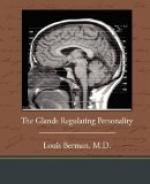More and more of the characteristics of the affection turn up. The queer, repulsive, pitiful face of the cretins, which makes them all seem brothers or twins, shapes itself. A yellowish, white or waxy pallor; rough, dry, scaly, bloated skin; swollen, often wrinkled brow; watery eyes, often almost concealed by the thickened eyelids; the depressed pug nose with its wide, thick nostrils; large, erect ears; the wobbly, drooling tongue, sticking out at one, yet not in derision; the hair thin, and like tow in texture rather than human; eyebrows and eyelashes are scant, and often absent; the nails short, thin and brittle; the teeth, very late in coming, may be represented by a few sharp points, irregular, decaying quickly, sometimes not succeeded at all by those of the second dentition.
Whatever growth occurs is irregular and disproportionate. The trunk, though small compared with the head, appears massive against the background of the diminutive extremities. The back is somewhat humped, arching at the waist-line, while the abdomen protrudes like a balloon, with a hernia, often, at the navel. The extremities are short, bowed, cold, and livid, covered with rolls of the infiltrated skin, rolls which cannot be smoothed out. Hands and feet are broad, pudgy, and floppy, the fingers stiff, square and spade-like, the toes spread apart, like a duck’s, by the solid skin. Above the collar bones there are frequently great pads of fat which sometimes encircle the narrow bull neck.
The mental state varies with the degree of deprivation of the internal secretion of the thyroid. In the worst cases it is repulsively vegetable. Even the intelligence common to the higher animals is wanting. The cretins of the “human plant” kind, as they have been nicknamed, will not recognize mother or father or any person about them, or even a person from an object, and manifest no interest in anything or anybody, not even toys. Hunger and thirst they manifest by grunts and inarticulate sounds, or by screaming. They neither smile, cough, nor laugh, but sit like sphinxes, breathing, but not reacting.
There are, of course, all grades and varieties. There are those who recognize parents and familiar faces, and exhibit some evidence of affection for them, acquire a limited vocabulary, and then cease, no progress possible even with the alphabet. They attain the size and age of two or three years and there stop altogether, as if a permanent brake were applied to the wheels of their growth. Some higher types may even come to speak connected sentences, and exhibit a certain mild spontaneity, though stupid and slow and abnormally deliberate, resembling the acquired form of thyroid deprivation or insufficiency, for which Ord invented the name myxedema.




